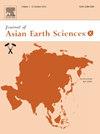Potential of random forest machine learning algorithm for geological mapping using PALSAR and Sentinel-2A remote sensing data: A case study of Tsagaan-uul area, southern Mongolia
IF 2.3
Q3 GEOSCIENCES, MULTIDISCIPLINARY
引用次数: 0
Abstract
Geological mapping in remote and geologically complex regions can be substantially improved by integrating remote sensing data with machine learning algorithms. This study evaluates the effectiveness of the Random Forest algorithm for geological mapping in the Tsagaan-uul area of the Khatanbulag ancient massif, Mongolia, a region characterized by limited accessibility and sparse field data. A comprehensive set of predictor variables was used, including Sentinel-2A spectral bands and indices, ALOS PALSAR digital elevation model, and terrain morphometric features. Two distinct training strategies were employed: (1) based on a geological map, (2) based on field-collected rock samples from two lithologically diverse formations. Variable importance was assessed using the Mean Decrease Gini index, while classification performance was measured through overall accuracy, precision, recall, F1-score, and the Kappa coefficient. In the first experiment, ALOS PALSAR DEM and Terrain Ruggedness Index were identified as the most influential predictors. Overall accuracy across all nine models ranged from 59.9 % to 64.4 %, with Kappa coefficients between 0.508 and 0.562. Model 1, which used a 90–10 % split, achieved the highest performance, while Model 4 recorded the lowest. These suggest that the data split ratio had a greater impact on model accuracy than the number of decision trees. In the second experiment, variations in the number of trees and variables per split had minimal effects, whereas the choice of stratification method significantly affected model outcomes. Overall, findings emphasize the critical role of dataset configuration, such as class balance and representative sampling, in optimizing Random Forest-based geological mapping.

随机森林机器学习算法在利用PALSAR和Sentinel-2A遥感数据进行地质填图中的潜力——以蒙古南部察干乌尔地区为例
通过将遥感数据与机器学习算法相结合,可以大大改善偏远和地质复杂地区的地质填图。本文评价了随机森林算法在蒙古可汗布拉克古地块察干乌尔地区地质填图中的有效性,该地区具有可及性有限、野外数据稀疏的特点。使用了一套综合的预测变量,包括Sentinel-2A光谱带和指数、ALOS PALSAR数字高程模型和地形形态特征。采用了两种不同的训练策略:(1)基于地质图,(2)基于从两个岩性不同的地层中现场采集的岩石样本。变量重要性评估使用平均减少基尼指数,而分类性能通过总体准确性,精密度,召回率,f1得分和Kappa系数来衡量。在第一个实验中,ALOS PALSAR DEM和地形崎岖度指数被确定为最具影响力的预测因子。所有9个模型的总体准确率在59.9%到64.4%之间,Kappa系数在0.508到0.562之间。使用90 - 10%分割的模型1获得了最高的性能,而模型4则记录了最低的性能。这表明数据分割率比决策树数量对模型精度的影响更大。在第二个实验中,每次分裂的树和变量数量的变化影响很小,而分层方法的选择显著影响模型结果。总体而言,研究结果强调了数据集配置(如类别平衡和代表性采样)在优化基于随机森林的地质填图中的关键作用。
本文章由计算机程序翻译,如有差异,请以英文原文为准。
求助全文
约1分钟内获得全文
求助全文
来源期刊

Journal of Asian Earth Sciences: X
Earth and Planetary Sciences-Earth-Surface Processes
CiteScore
3.40
自引率
0.00%
发文量
53
审稿时长
28 weeks
 求助内容:
求助内容: 应助结果提醒方式:
应助结果提醒方式:


